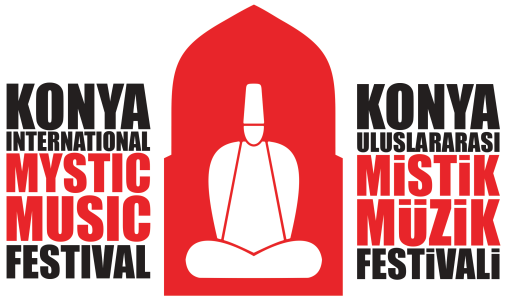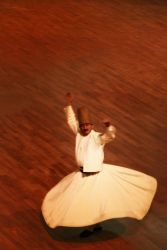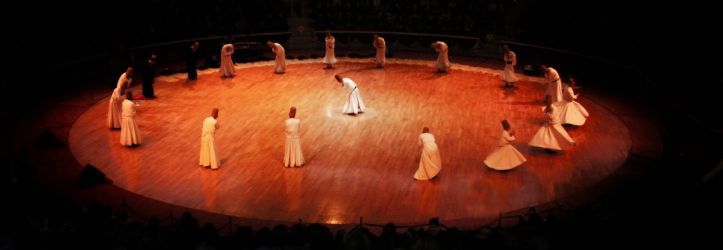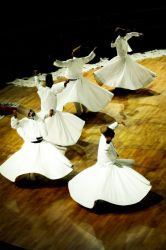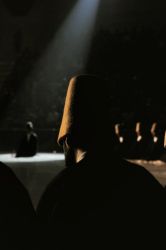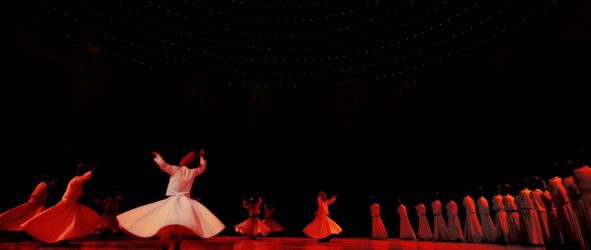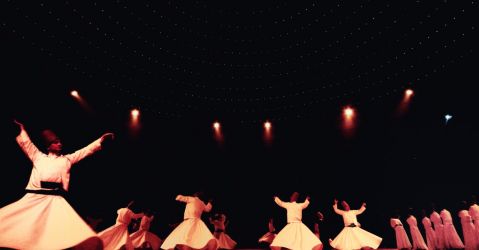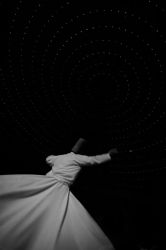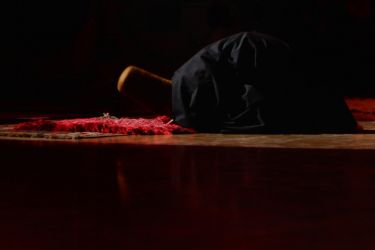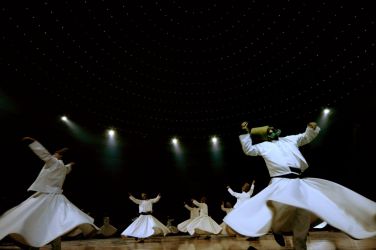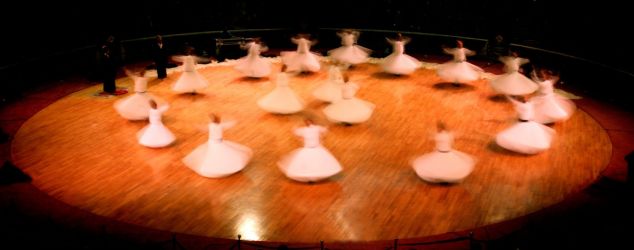Semâ' (Whirling) Ceremony
The literal meaning of the word "Semâ’" is "to hear". For Mevlevi dervishes, it carries the added meaning of being enraptured while listening to music, being in motion and whirling. It symbolically refers to the creation of the universe and humankind's coming into being. It also refers to one's acting on both her love for the Grand Creator and on the perception of her station as servant of that creator while maturing into the "Perfect Man". Sema is a zikhir said silently while whirling on foot. The whirling dervishes silently call "Allah" inwardly on every whirl.
The Sema Ceremony was performed in Mevlevi Lodges in this way: A procession consisting of the "neyzenbasi" (the head of the ney-players), the "kudumzenbasi" (the head of the kudum-players), the other musicians called "mutriban", the "semazenbasi" (the head of the Dervishes), the dervishes themselves called "semazen" and then the Divine Guide who is the Sheikh, enter into the Sema Hall by greeting a reddened sheepskin (the sheepskin of the Sheikh). The sheepskin represents the presence of Mevlana, and so is regarded as sacred by the Mevlevi; the Mevlevi never turn their backs to it.
Those who participate in the Sema and its spectators collectively perform the Namaz together and pray with beads. Then either the Sheikh, or someone chosen by him, reads couplets from the Mesnevi and provides commentary.
The procession is followed by the Na't which is praise for the pretext for the universe's creation, the Prophet Muhammed (PBUH). The Na't, whose words were written by Hz. Mevlana for the Prophet Muhammad (PBUH), and whose music was composed by the great 17th century composer Buhurizade Mustafa Itri Efendi, is read while standing and without any instrumental accompaniment as a matter of respect. The lyrics of the Na't are as follows:
O the Beloved of Allah! You are the Prophet of the Mighty Creator
You are pure and peerless amongst the servants of Allah.
You, the courteous one of Allah the Exalted, you are the one who reached perfection
You are the divine glory of the Prophets, our divine light to our eyes.
Gabriel was your carriage on the Night of Ascension
You are the one who reached the green vault over nine presences
O the Prophet of Allah! You know that Your community is incapable
You are the Guide of those weak ones who do not have head nor feet.
The cypress of the Prophets' Garden, You are the spring of the world of insight
You are the rose of the Sharia Garden, the Exalted Hyacinth!
Shams of Tabriz knew this praise of the Prophet by heart
You are the Exalted One, Mustafa and Mucteba
The Kudum drum is struck immediately after the Na't. This single Kudum stroke symbolizes the Order "Kun!" (Be!) of the Mighty Creator. "Unique Creator of the heavens and the earth, and when He decrees an affair, He only says to it, Be, so there it is (Verse of Holy Quran; II, 117)".
With the beat of the Kudum, the head of the Ney players bridges the mode of the Na't with that of the Ayin (the main body of music to be played in the ceremony) in his Ney improvisation. The Ney improvisation symbolizes the Divine Breath of God blowing life into the universe. As the improvisation comes to a close, the musicians begin to play the prelude to the Ayin, the Peshrev. Concurrently, the Sheik and the dervishes hit the floor with their hands, kiss it and then stand up. This hitting represents the "Revival" and is called "Darb-i Celali" meaning "The beat of Majesty".
The Sheikh, together with the Whirling Dervishes and their head, according to their seniority levels, begin to walk three full circles from right to left. This walk is called the "Devr-i Veledi" (the Cycle of Veled) in the name of Sultan Veled, the son of Hz. Mevlana.
While the "Devr-i Veledi" is being performed, "Mukabele" meaning "meeting/reciprocation" takes place before the sheepskin of the Sheikh.
An imaginary line extending from the end of Red Sheepskin to the end of the Sema Hall divides the area into two parts representing the visible and invisible spheres. This imaginary line is called "Hatt-i Istiva" (the Line of Equality). Since it represents "the shortest path to the Grand Creator" it is deemed as sacred and never stepped on by the Mevlevi.
When a whirling dervish comes in front of the Red Sheepskin, he, without turning his back to it and without stepping on the Hatt-i Istiva, steps over it and then faces the dervish following behind him. For a moment, the two dervishes bow and greet each other respectfully while looking into each other's eyes. Where the walk's circular path intersects the Hatti Istiva again, the dervish greets the Hatti Istiva respectfully before stepping over it.
The black dervish's cloak symbolizes the grave of the self. The "sikke", a headgear made of felt, symbolizes the headstone of the self, whereas the "tennure", the white dress, is the shroud of the self. When the head of the kudum players signals with a drumbeat that the Cycle of Veled has ended, the head of the ney players begins a brief ney improvisation to smoothen the transition from the interrupted Pesrev to the Ayin. During the improvisation, the whirling dervishes take their places and take off their cloaks. They respectively kiss the hand of the Sheikh and get his permission to whirl. The Sheikh allows them to whirl by kissing their headgear.
The Ayin consists of four parts corresponding to the four stages on the journey to the reunion with Allah.
1. The first part represents the human's realization of his station of servitude before the Grand Creator.
2. The second part represents the human's wondering admiration of the omnipotence of God by recognizing His order and grandeur in creation.
3. The third part represents the human's admiration turning into love. It symbolizes being enraptured by divine love, being nonexistent within the Beloved through full surrender. It is ascension.
4. The fourth part represents being enslaved fully to God by completing the divine journey.
The Dervishes extend their arms, the right palm faces up and the left palm faces down. This position means "We take from God, and give to the public".
The sheikh and the head of the dervishes participate in the fourth/last part. Two additional musical pieces are played, the "Son Peshrev" and "Son Yuruksemai". During the final instrumental improvisation, the Sheikh, having completed his whirling session, returns to his post.
When the last improvisation draws to a close, a member of the chorus recites the Holy Quran. The Sema is then over, and the dervishes, having put on their black cloaks, sit back.
The verses of the Holy Quran, especially Al Baqarah, is recited here:
- Sura II, Verse 115. And God's is the East and the West: and wherever you turn, there is God's countenance. Behold, God is infinite, all-knowing.
- Sura II, Verse 116. And they say: Allah has taken to himself a son. Glory be to Him; rather, whatever is in the heavens and the earth is His; all are obedient to Him.
- Sura II, Verse 117. Mighty Creator of the heavens and the earth, and when He decrees an affair, He only says to it, Be, so there it is.
Then the Sheikh calls for prayer, saying "Al Fatihah". Everybody reads the sura silently. Then the head of the dervishes, or somebody else, leads in another prayer.
The sheikh once more calls for prayer, again saying "Al Fatihah", and then another prayer is chanted in unison. "Hu", meaning Allah, is prolonged when the last greetings begin. The sheikh, walking across the Sema Hall, addresses the dervishes:
"Esselamun a'leykum" (Peace be with you). The head of the dervishes, together with the dervishes, respond with "vealeykumusselam ve rahmetullah-i ve berekatuhu", prolonging the final syllable "hu". The Sheikh takes a few steps and salutes the musicians and chorus as well. The head of the Ney players receives this salute on behalf of the musicians.
The Sheikh, while departing from the Sema Hall, greets everyone once more; and the head of the dervishes, the dervishes, the chief of the Ney players and musicians leave the Sema Hall respectively, but not without saluting the Red Sheepskin.
These representations refer to humankind's exaltation by turning towards the Creator through reason and love; his release from the captivity of the self; his maturation into a Perfect Man; and his return to the point from which he began. However, to return to this starting point, one has to first become a slave of Allah, mature spiritually, embrace not only other humans, but also animals, plants, even nonliving matter. In short, one is to embrace all creatures with love and to devote oneself to His service. Namely, one becomes the "all-knowing human". As Allah the Exalted decrees in the Holy Quran:
Are those who know and those who do not know equal? Sura; XXXIX, 9
Instruments
As the Mevlevi have broad views and open minds, they employed all kinds of instruments in their music. They chose instruments that were compatible with their music, including Western instruments such as the violin, the viola and the violoncello. According to the sources, the first piano brought to Istanbul was played in the Galata Mevlevi Lodge; however, it was not used again since it did not have all the tones used in Turkish Music. In fact, the ney, the kudum, the rebab and other percussions like the bendir, the daire, the halile became indispensable.
Ney
It is known that the Ney has been in use since about 5000 B.C. It takes its name from the word "na", which in the Sumerian language means "reed". The Ney touches the hearts of people in every age with its mystical and religious overtones; and it never fails to allure with its deep and harmonious sound.
Since the conversion of the Turks to Islam in the 10th century, the mystical thought that had already infused Turkish society has been reframed as Turkish Sufism in light of the Islamic pillars. This understanding of sufism, beginning with Hoca Ahmed Yesevi, developed further with Haci Bektas-i Veli, Yunus Emre and Mevlana Celaleddin-i Rumi.
The Ney is the symbol of the "Perfect Man" who has matured by passing through many phases of purification. The Ney, discolored, hollowed out and bored through with holes, pines for its reed bed. While pining, it mournfully wails its innermost secrets to all mankind. These secrets are divine revelations about the love. For this reason, the Ney is deemed as sacred and called "nay-i serif".
The Ney is made up of a special type of yellow–colored reed consisting of tough fibers and nine naturally joined segments. It grows abundant in warm moist climates. The choicest varieties are to be found growing along the Nile, Asi and Ceyhan Rivers. What is usually the case is that in a reed bed of a thousand reeds, perhaps only one single reed is suitable for producing the Ney. Any dyestuff or wax is not used in Ney production with a mind to preserving its natural attributes. A Ney can remain in service for well up to 200-300 years with even a gradual increase in playablity provided that it is well protected and properly maintained. A Ney’s color may darken in the course of time, and if this is the case, it is considered more precious.
The Ney has seven holes, six in the front and one at the back. Metal rings, called "parazvane", are fitted tightly to both the top and bottom of the Ney so as to prevent cracking. In addition, a mouthpiece, or "baspare", is fitted into the top of the Ney to produce clearer sounds and to protect the lips. This mouthpiece is usually manufactured from either buffalo-horn, ivory, ebony or hard wood varieties such as box-wood. The Ney has a playing range of three octaves. This enables every kind of music to be made, since every sound in nature can be reproduced by adjusting the temperature, direction or force of the breath, or by adjusting how much of an aperture is covered.
Rebab
The only bowed instrument in the Turkish repertoire for a period of about a thousand years spanning both Seljuk and Ottoman times was the rebab; and throughout that time it was deemed as one of the most important instruments in the music of the Mevlevi. According to some sources, the prominent status of the rebab in Anatolia is indebted to Hz. Mevlana. The very same sources inform us that the instrument was played by both Hz. Mevlana and his son, Sultan Veled, the founder of the Mevlevi School.
In yet earlier times, the prototype of the rebab, the "iklig", had been widely used in Central Asia. The rebab was introduced to Spain by Arabs, and from there, to all of Europe; and it became one of the most popular instruments in Europe during the Middle Ages.
Its body consists of a halved coconut shell with either thin leather or the membrane of a cattle’s heart stretched across the opening. Protruding from the body is a rather cylindrical neck with wooden tuning pegs at one end. It has a foot stand, or holder, made of wood or metal. The strings hold the bridge in place over the stretched skin of the body. The sound of the rebab is produced by moving the bow hairs over the strings. The strings are also made of hairs.
It produces touching emotional tones.
Kudum
One of the oldest percussive instruments, the kudum is as indispensable as the Ney when it comes to Mevlevi music.
Kudum beats are said to be the footsteps in a melody stepping from one section to the next. That is why it is referred as "kudum" that means "stepping".
Made of beaten copper, the kudum consists of two drums, each 28-30 cm. in diameter and 16-18 cm in height. Tanned leather or camel leather thinned to a thickness of 1-2 mm. are stretched over each drum with the help of ropes. The kudum is tuned by tightening or loosening the ropes. The accented right-handed drum taps are called "tek", and the weaker left-handed taps are "dum". The auxiliary taps into which rhythms are subdivided are called "velvele".
The sides and bottom of the copper drums are cased in felt or wool stuffing in order to prevent them from producing unpleasant clanging sounds.
The drums themselves are placed on two leather rings stuffed with cotton. The rings are called "simit", as their shape resemble the Turkish sesame-covered roll of that name.
The kudum is played with two wooden sticks called "zahme". These are made of hard and heavy wood and are roughly 24-28 cm. in length. A person who plays kudum is called a "kudumzen".
The smaller drum of the kudum is called "nakkare", and the bigger one is "kos; and the two are used in Mehter Music (the band music of the Ottoman military).
The Mevlevi Sufis called the kudum "kudum-i serif" (the sacred kudum), thus regarding the kudum as sacred, as the Ney was regarded as sacred.
In a poem attributed to Mevlana, the Ney and the Kudum are mentioned as such:
"The reed is dry, the drumstick’s dry, and the leather stretched over the dry copper drum is dry,
So from where does this Friend’s call come?"
Bendir and Daire
The Bendir and the Daire, percussive instruments composed of leather stretched over a wooden frame, were used in Central Asia, the Middle East and Anatolia for hundreds of years.
The bendir, known as "mazhar" or "bender", became the instrument used most in Tekke Music (ritualistic religious music) after the Turks converted to Islam and settled in Anatolia. One would never hear a bendir in music that was other than religious. Use of the bendir then spread from Anatolia to the Balkans, and then to the rest of Europe.
Usually made from walnut wood, the frame is 30-60 cm. in diameter and 6-8 cm. wide. The skin, less than 1 mm. thick, is stretched across it. Usually camel, cattle, goat and sheep leathers are preferred.
A series of rings, called "zincir", serve as snares, which are usually made of gut. When the drum head is struck, the snares, stretched across the underside of the skin, produce a buzz. Bendirs with snares are called "zikhir bendir".
Like the other instruments in Tekke Music, the bendir is assigned a sacred status with the name "bendir-i serif", or "mahzar-i serif" (the sacred bendir, or mahzar, respectively). The bendir is to be played with the hands, with one hand holding it from below. It is held above waist level, and never placed on the knee or between the legs. It is played with the fingers, palm and backside of the free hand, which strike the skin at varying angles and with varying strength. The result is such that the skin is either struck or brushed. The free hand can be accompanied by the fingers of the hand holding the instrument.
A similar instrument is the daire, which is 30-40 cm. in diameter and of approximately the same width as the bendir . The daire’s frame is perforated with five pairs of holes, to which small cymbals, 8-10 cm. in diameter, are fitted. There are two cymbals to a hole. The daire has generally been used in secular music; but when played in tekkes, if at all, it was called "def". However, the def, as known in the realm of secular music, was somewhat different. The "real" def resembles the daire, but it has a smaller frame of 25-30 cm. in diameter, with four pairs of tiny cymbals to a hole; and its rich and high-pitched chink-chinking suited music played for entertainment.
Those who play bendir are called "bendirzen", while those who play the def are "defzen".
Halile
The discs of this percussive instrument, resembling pot covers, are played by either clashing the two discs head-on, or by sliding them across each other. The discs are pierced at their centers where leather handles are tied. It is possible to produce high or low pitched sounds which are either staccato or sustained.
This Turkish instrument, originating in Central Asia, could be made from various alloys and metals.
It had the earlier names "cang" or "sanc", and then "zil". Those who played it were called "zilzen".
According to sources, it was later to be found also in Europe; and it was called in the circles of Classical European Music as "Cimbalen Turgues". It is now called the Cymbal.
The cymbals used in Mevlevi Music, smaller than those used in Mehter Music, are known as "halile". Halile players are called "halilezen".
Source: "Dr. Timuçin Çevikoğlu (2008). While Whirling the Love in the Heart Renews. Konya: Governership of Konya Provincial Directorate of Culture and Tourism Publications."
Ministry of Culture and Tourism
Konya Turkish Sufi Music Ensemble
The Sema (Whirling) Ceremony will performed by Konya Türk Tasavvuf Müziği Topluluğu. The Ensemble specialized on Mevlevi Music and the Sema (Whirling) Ceremony was established in 1991. The Ensemble has continued to perform Sema Ceremony on Shab-i Arus and other periodic performaces every year since its establishment.
Yusuf Kayya
He was born in Kütahya in 1963. He graduated from Ankara University, Faculty of Language History and Geography, department of Arabic Philology in 1985. He started his career in music in Kutahya; learning how to play ney from ney player-painter Ahmet Yakuboğlu. He benefited from the ney player Uğur Onuk. He was assigned to Ankara Radio passing the qualified instrument player test prepared by the Turkish Radio and Television Association (TRT). He worked as an expert in TRT Music Department. He joined The Turkish Republic Ministry of Culture and Tourism's Konya Turkish Sufi Music Ensemble that was established in 1990. He gave lectures in Selçuk University Faculty of Education and State Conservatory.
In 1997, he was appointed as Konya Turkish Sufi Music Ensemble Assistant Art Director. He is serving as Ensemble’s Art Director dated from 2004.
Ahmet Çalışır, Assistant Director
Fahri Özçakıl , Manager
Vocalists
- Ahmet Çalışır
- Ahmet Uncu
- Ali Kalaycı
- Habib Alparslan Tabak
- Hüseyin Alp Özel
- Enver Özel
- Mehmet Ali Türkoğlu
- Ufuk Yürüç
- Vedat Tüzün
- Mehmet Emin Kabakçı
Instrumentalists
- Mehmet Öztorun, kudûm
- Osman Acar, halîle
- Süleyman Yardım, ney
- Mahmut Uğurluakdoğan, ney
- Muhammed Şükrü Fırat, ney
- Ahmet Safa Mızrak, ney
- Mustafa Celalettin Aksoy, kânun
- Hakan Kılınçarslan, kânun
- Ali Vefa Sağbaş, kemençe
- Emre Apaydın, kemençe
- Mehmet Uçak, ud
- Musa Kazım Tığlıoğlu, tanbur
- Tikel Akın Özkök, cello
Sema Group (Whirling Dervishes)
- Fahri Özçakıl, postnişîn
- Ahmet Sami Küçük, semâzenbaşı
- Nuri Yılmaz, semâzen
- Ahmet Tekelioğlu, semâzen
- Muammer Ünal, semâzen
- Hüseyin Sıtkı Holat, semâzen
- Mehmet Emin Holat, semâzen
- Sıtkı Çokünlü, semâzen
- Reşat Varol, semâzen
- Orhan Tekelioğlu, semâzen
- Ömer Faruk Erdem, semâzen
- Özhan Gültepe, semâzen
